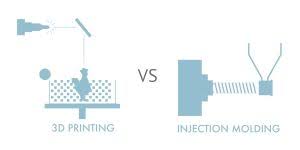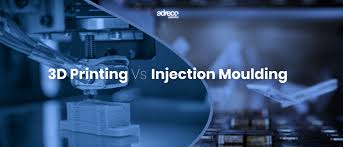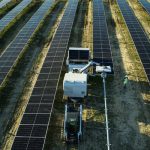Introduction
When it comes to manufacturing, two of the most commonly used methods are injection molding and 3D printing. Each has its advantages and limitations, making them suitable for different applications. The choice between these technologies depends on factors such as production volume, material selection, cost, speed, and design complexity. In this article, we will explore the key differences between injection molding and 3D printing to determine which one is better suited for various use cases.
What is Injection Molding?

Injection molding is a manufacturing process where molten material (usually plastic, metal, or rubber) is injected into a mold cavity under high pressure. Once cooled and solidified, the part is ejected from the mold, resulting in a finished product.
Advantages of Injection Molding:
- High Production Efficiency: Capable of mass-producing thousands to millions of identical parts efficiently.
- Cost-Effective for Large Runs: While the initial mold cost is high, the per-unit cost decreases significantly with volume.
- Strong and Durable Parts: Produces high-strength, durable parts with excellent surface finish.
- Wide Material Selection: Compatible with various thermoplastics, thermosetting polymers, and elastomers.
- Precision and Consistency: Ensures tight tolerances and repeatability in production.
Disadvantages of Injection Molding:
- High Initial Costs: Mold creation is expensive, often costing thousands of dollars.
- Longer Setup Time: Designing and producing the mold can take weeks or months.
- Limited Design Flexibility: Design changes require costly mold modifications.
- Not Ideal for Small Batches: The high upfront investment makes it inefficient for low-volume production.
What is 3D Printing?
3D printing, also known as additive manufacturing, is a process where material is deposited layer by layer to create a three-dimensional object. This process does not require molds and can work with various materials, including plastics, metals, resins, and composites.
Advantages of 3D Printing:
- Rapid Prototyping: Ideal for quickly creating prototypes and small-scale production.
- Low Initial Costs: No expensive molds required; cost depends on material usage and machine type.
- High Design Flexibility: Allows complex geometries and customization without additional costs.
- Reduced Material Waste: Uses only the necessary material, minimizing waste.
- Faster Turnaround for Low Volumes: Produces parts quickly without the need for lengthy setup times.
Disadvantages of 3D Printing:
- Limited Production Scale: Not efficient for large-scale production due to slower printing speeds.
- Higher Per-Unit Cost for Large Runs: More expensive than injection molding when producing thousands of parts.
- Material Constraints: While expanding, material options are still more limited compared to injection molding.
- Surface Finish and Strength: May require post-processing for a smooth finish, and some materials lack the durability of molded parts.
Comparison Table
| Factor | Injection Molding | 3D Printing |
|---|---|---|
| Production Volume | Best for high-volume production | Best for low-volume, prototyping |
| Cost | High initial investment, low per-unit cost for large runs | Low initial cost, higher per-unit cost for large runs |
| Lead Time | Longer due to mold creation | Shorter for prototyping and small batches |
| Material Choices | Extensive material options | Growing selection but still limited |
| Complexity & Customization | Limited; expensive to modify molds | High flexibility, easy modifications |
| Durability | Strong, long-lasting parts | Variable durability depending on material |
| Surface Finish | Smooth, ready-to-use | Often requires post-processing |
Which One is Better?
The answer depends on your specific needs:
- Use Injection Molding if you need mass production, high-strength parts, and cost efficiency for large volumes.
- Use 3D Printing if you require rapid prototyping, small batches, or highly customizable designs.
Conclusion
Both injection molding and 3D printing have their place in modern manufacturing. Injection molding remains the dominant method for large-scale production, while 3D printing is revolutionizing prototyping and on-demand manufacturing. By understanding their strengths and limitations, businesses can choose the right method based on their project requirements and budget.


